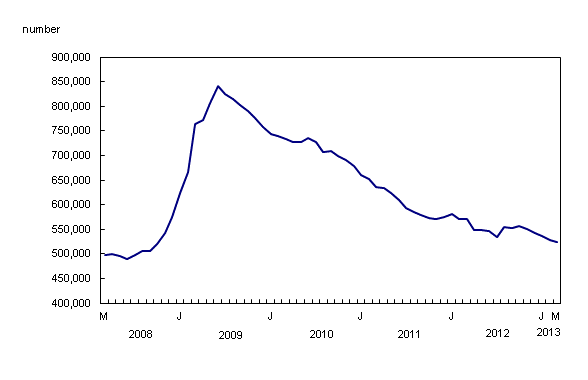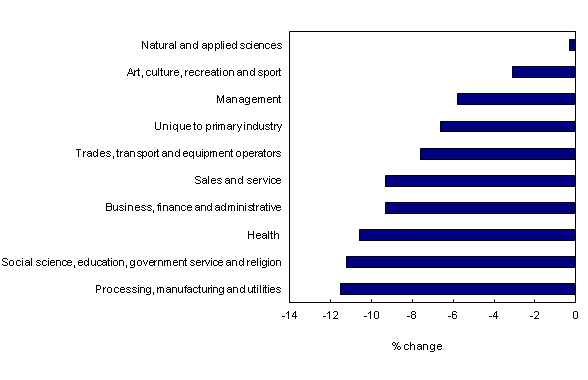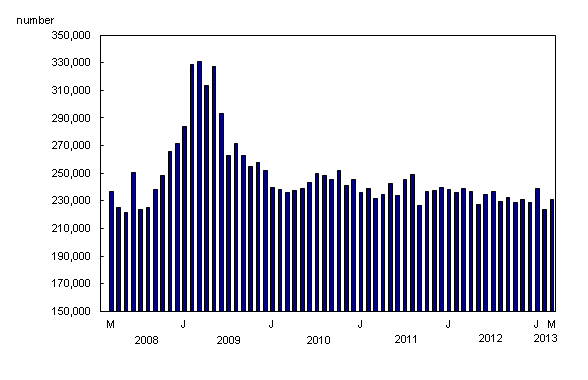Employment Insurance, March 2013
Archived Content
Information identified as archived is provided for reference, research or recordkeeping purposes. It is not subject to the Government of Canada Web Standards and has not been altered or updated since it was archived. Please "contact us" to request a format other than those available.
Released: 2013-05-23
The number of people receiving regular Employment Insurance (EI) benefits continued to trend down for the fifth consecutive month in March, declining slightly by 1.0% (-5,200) to 523,700. Compared with a year earlier, the number of beneficiaries was down 8.1%.
All four Western provinces as well as Newfoundland and Labrador had fewer beneficiaries in March, while there was little change in the other provinces.
Highlights on the provinces and metropolitan areas
The number of regular EI beneficiaries in Saskatchewan fell 3.1% in March. This was the fourth consecutive monthly decrease for the province. Both Saskatoon (-3.8%) and Regina (-2.1%) had fewer beneficiaries than in the previous month.
In Alberta, the number of people receiving benefits fell for the fourth consecutive month, down 2.6% in March. In Calgary, the number of beneficiaries decreased for the third month in a row, down 2.5%. At the same time, there was little change in Edmonton.
The number of people receiving regular benefits in British Columbia declined 2.4% in March, continuing a seven-month downward trend. Of the four metropolitan areas in the province, three posted declines, with Abbotsford–Mission (-6.6%) recording the largest. The decline in Abbotsford–Mission was also the largest monthly percentage decline among all metropolitan areas in the country. Decreases also occurred in Vancouver (-1.8%) and Victoria (-1.3%). In Kelowna, the number of beneficiaries increased 1.9%, following a decline the previous month.
There were 2.1% fewer beneficiaries in Newfoundland and Labrador, the fourth consecutive monthly decline in the province. In the metropolitan area of St. John's, the number of beneficiaries decreased by 1.7%, continuing an eight-month downward trend.
In Manitoba, the number of people receiving regular benefits fell 1.4% in March, the fifth monthly decrease in a row. In Winnipeg, the number of beneficiaries was down 1.7%, the second consecutive monthly decline.
After four months of decline, the number of beneficiaries in Quebec was little changed in March. There was also little change in Montréal, where the number of people receiving benefits stood at 55,000.
The number of beneficiaries in Ontario was virtually unchanged from the previous month. In Toronto, 62,900 people received benefits in March, unchanged from February.
Compared with 12 months earlier, most metropolitan areas had fewer beneficiaries, with the declines ranging from 2.0% in Halifax to 20.7% in Abbotsford–Mission. At the same time, four metropolitan areas posted increases, ranging from 4.3% in Oshawa to 15.9% in Greater Sudbury. Regina was the only area where the number of beneficiaries was virtually unchanged.
Employment Insurance beneficiaries by occupation
In March, three major occupation groups posted notable declines in the number of beneficiaries compared with the previous month. The largest decrease came in art, culture, recreation and sport, where the number of people receiving regular benefits fell for the second consecutive month in March, down 2.3%.
Notable monthly declines also occurred in health occupations (-2.1%) and in occupations in social science, education, government service and religion (-1.9%). In both of these occupation groups, the decline in March was the fifth in a row. There was little or no change in the other occupation groups.
Compared with 12 months earlier, all occupation groups posted declines, with the exception of natural and applied science occupations where the number of beneficiaries was unchanged. These declines ranged from 3.1% in art, culture, recreation and sport to 11.5% in occupations unique to processing, manufacturing and utilities.
Employment Insurance beneficiaries in major demographic groups
The number of regular EI beneficiaries among women fell for the fifth consecutive month, down 1.6% in March, and was shared between women aged 15 to 24 (-2.2%) and those aged 25 to 54 (-1.7%). Among women 55 and over and men of all age groups, the number of beneficiaries was little changed from the previous month.
On a year-over-year basis, the slowest rate of decline continued to be among people 55 and over (-1.9%).
Claims increase in March
To receive EI benefits, individuals must first submit a claim. The number of claims provides an indication of the number of people who could become beneficiaries.
The number of initial and renewal claims rose by 6,800 (+3.0%) to 230,700 in March, partly offsetting the decline observed the previous month. Alberta (+12.6%) posted the largest percentage increase in claims in March, followed by New Brunswick (+4.1%).
Smaller percentage increases occurred in Nova Scotia (+3.5%), Quebec (+3.5%) and Ontario (+2.7%), while there was little or no change in the other provinces.
Note to readers
Regular Employment Insurance (EI) benefits are available to eligible individuals who lose their jobs and who are available for and able to work, but can't find a job. The change in the number of regular EI beneficiaries reflects various situations, including people becoming beneficiaries, people going back to work, and people exhausting their regular benefits.
There is always a certain proportion of unemployed people who do not qualify for benefits. Some unemployed people have not contributed to the program because they have not worked in the past 12 months or their employment is not insured. Other unemployed people have contributed to the program but do not meet the eligibility criteria, such as workers who left their job voluntarily or those who did not accumulate enough hours of work to receive benefits.
New content and historical revision (released in March 2013)
Data on people who receive regular EI benefits are now available by detailed age and for 140 occupation groups. New seasonally adjusted data by sex, age, census metropolitan area, census agglomeration and occupation are also available. The definition of regular EI beneficiaries has been expanded to include those receiving regular benefits while participating in employment benefit programs, such as training. Furthermore, self-employed people receiving special benefits are now included in the special benefits category.
Geography boundaries have been updated from the 2001 to the 2006 Standard Geographical Classification (SGC), which mainly affects boundaries of census metropolitan areas and census agglomerations.
To preserve consistencies across time despite all of the above changes, all EI data series have been the subject of an historical revision going back to January 1997.
All data are available on CANSIM.
All data in this release are seasonally adjusted. For more information on seasonal adjustment, see Seasonal adjustment and identifying economic trends.
EI statistics are produced from administrative data sources provided by Service Canada and Human Resources and Skills Development Canada. These statistics may, from time to time, be affected by changes to the Employment Insurance Act or administrative procedures. Recent examples are the pilot project entitled "Working While on Claim," introduced on August 5, 2012, and the regulation on search for suitable employment, that came into effect on January 6, 2013.
The number of regular EI beneficiaries and the number of claims received for the current and previous month are subject to revision.
The number of beneficiaries is a measure of all people who received EI benefits from March 10 to 16. This period coincides with the reference week of the Labour Force Survey (LFS).
EI statistics indicate the number of people who received EI benefits, and should not be confused with LFS data, which provide information on the total number of unemployed people.
Data tables are also now available online. From the Browse by key resource module of our website under Summary tables, choose Subject, then Labour.
Data on Employment Insurance for April will be released on June 20.
Contact information
For more information, contact us (toll-free 1-800-263-1136; infostats@statcan.gc.ca).
To enquire about the concepts, methods or data quality of this release, contact Vincent Ferrao (613-951-4750; vincent.ferrao@statcan.gc.ca), Labour Statistics Division.
- Date modified:




